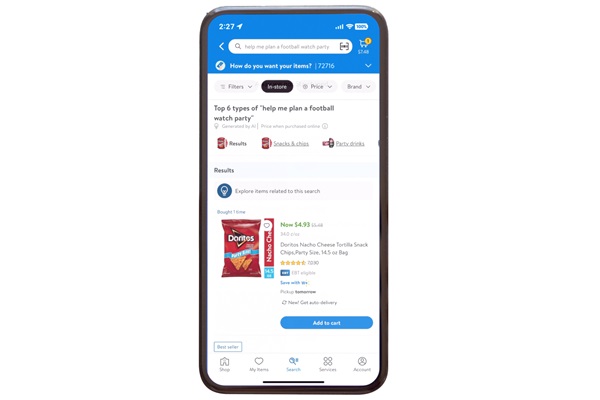Walmart Unveils Generative AI Search and In-Home Refills
 Walmart showcased a new generative AI plans search feature, among other new technological upgrades, at CES this year. The new search feature is designed to enhance customer experiences by allowing users to seek out products based on specific use cases rather than traditional products or brand names.
Walmart showcased a new generative AI plans search feature, among other new technological upgrades, at CES this year. The new search feature is designed to enhance customer experiences by allowing users to seek out products based on specific use cases rather than traditional products or brand names.
Walmart Generative AI Search
The generative AI search feature will bring more pertinent and wide-ranging results than the usual keyword system, according to Walmart. The company cites planning for a football watch party as an example. Typing that into the new search function would bring up all the necessary items in one go—as opposed to just items that have football in their name.
The new feature employs a blend of Walmart’s proprietary data and technology, with large language models (LLMs) accessed through Microsoft Azure OpenAI Service and tailor-made retail-specific models. The search tool is also fine-tuned to deliver a bespoke list of products aligned with shopper intent. It will even respond based on more specific factors such as location, search history, and other contextual data to refine the results.
Relatedly, Walmart is piloting a generative AI-based system for streamlining the replenishment of frequently purchased items. This InHome Replenishment tool relies on AI to preemptively fill shopping carts with the right items at the right time, mirroring a personal shopping assistant’s foresight. The service delivers items straight to customers’ fridges or garages via the smart lock-powered InHome delivery service—without binding customers to a subscription. Shoppers maintain full command over their orders, with options to skip, add, or adjust items, as well as modify delivery schedules to suit their convenience. The intention is to automate the entire shopping process, from cart creation to doorstep delivery, offering an unparalleled level of efficiency.
“We build technology to serve people and not the other way around,” Walmart president and CEO Doug McMillon explained. “Walmart’s purpose is to help people live better, and today, more than ever, advances in technology make it feel like anything is possible. Our technology roadmap is compelling and we’re very excited about it, but we’re clear that we are a people-led, tech-powered company. People, our customers and associates, come first and we’ll put technology to work to serve them better than ever.”
Existing Walmart generative AI tools are also getting a boost, with the company widening access to its generative AI assistant for store associates, My Assistant, to 11 additional countries outside the U.S. this year. This expansion will introduce the AI assistant to a global workforce, operating in the employees’ native languages to aid with tasks such as writing, document summarization, and creative ideation. Already a fixture in North and Central America, My Assistant is poised for launches in India and South Africa, marking Walmart’s commitment to harnessing AI to enhance workplace productivity.
Walmart has been hinting at a generative AI-powered shopping assistant for some time, and the search feature moves the company in that direction. The ultimate vision by the retail giant is to also help with decorating homes by creating 3D models of products from images. This allows for realistic visualization of furniture, clothes, and electronics in physical spaces. It’s similar to Wayfair’s Decorify service, which lets users upload photos of their homes and see what they might look like if redecorated in different styles using furniture available on Wayfair.
Walmart’s connection to AI goes back several years, with a voice assistant project coming out back in 2017 through direct ordering through Google Home devices before switching to Google Assistant integration in 2019 and adding Siri. There was also a flurry of conversational AI projects at Walmart’s Store Nº8 incubation division, including a Text to Shop feature allowing shoppers to text their list to a chatbot and the Ask Sam voice app to answer employee queries about product prices and locations. Walmart capped it off by acquiring conversational design firm Botmock in late 2021.
Follow @voicebotaiFollow @erichschwartz
Walmart Teases Generative AI Chatbot and Synthetic 3D Images for Online Shopping








